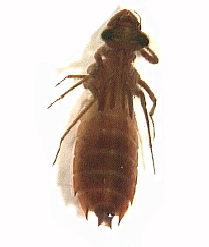 Aquatic Insects of Michigan
Aquatic Insects of Michigan
by Ethan Bright, Museum of Zoology Insect Division and School of Natural Resources and Environment
University of Michigan
- Home
- Species Lists
- Coleoptera
- Diptera
- Ephemeroptera
- Acanthametropodidae
- Ameletidae
- Ametropodidae
- Arthropleidae
- Baetidae
- Baetiscidae
- Behningiidae
- Caenidae
- Ephemerellidae
- Ephemeridae
- Heptageniidae
- Isonychiidae
- Leptohyphidae
- Leptophlebiidae
- Metretopodidae
- Neoephemeridae
- Oligoneuriidae
- Palingeniidae
- Polymitarcyidae
- Potamanthidae
- Pseudironidae
- Siphlonuridae
- Heteroptera
- Hymenoptera
- Lepidoptera
- Megaloptera
- Neuroptera (Sisyridae)
- Odonata
- Orthoptera
- Plecoptera
- Trichoptera
- Other Orders
- Keys/Identification
- Aquatic Insects of Michigan
Pachydiplax Brauer, 1868 (Libellulidae) (Blue Dasher) of Michigan - Identification
A wide-ranging North American single species - Pachydiplax longipennis (Burmeister, 1839) - is found here in Michigan. Most records are from the southern LP, but several records are from the northern part of the LP.
Adults are medium-sized and bluish (male) or brownish (female), with clear wings with a black pterostigma, whitish face, and striped thorax and abdomen. Males have beautiful bluish-greenish eyes, with the body generally blue with a black-tipped abdomen. Females are generally yellowish-brown with a black pattern, and reddish eyes. The nymph is smooth, their broad head distinctly characterized with a prominent dark ridge running mesad from the mesoposterior part of the eye, and prominent lateral spines on the abdomen (Walker and Corbet 1975).
Adults may be quite abundant flying around wetlands and slower vegetated sections of lotic systems. Nymphs are found in lakes and ponds as well as in slow sections and backwater areas of streams. Bick (1950) in Mississippi collected larvae from standing water with a mud bottom, in ponds, borrow pits or creek pot holes. Musser (1962) collected larvae in Utah from aquatic vegetation along the edge of a spring-formed pond. Emergence in our area is from late May through probably July. Populations in Michigan are probably univoltine, as Paulson and Jenner (1971) found overwintering larvae in North Carolina, but populations probably have overlapping generations in the southern portion of its range (Penn 1951, Morin 1984, Wissinger 1988).
Taxonomic references: Needham et al. 2010, Paulson 2011, Walker and Corbet 1975
References
Bick GH. 1950. The dragonflies of Mississippi (Odonata: Anisoptera). American Midland Naturalist 43:66-78.
Morin PJ. 1984. The impact of fish exclusion on the abundance and species composition of larval odonates: results of short-term experiments in a North Carolina farm pond. Ecology 65: 53-60.
Musser RJ. 1962. Dragonfly nymphs of Utah (Odonata: Anisoptera). University of Utah, Biological Series 12(6). 66 pp.
Needham JG, Westfall MJ, May ML. 2010. Dragonflies of North America, Third Edition. Scientific Publishers, Gainesville, Florida, USA. xiv + 657 p.
Paulson D. 2011. Dragonflies and damselflies of the East. Princeton Field Guides. Princeton University Press, Pinceton, New Jersey, USA. 538 p.
Paulson DR, Jenner CE. 1971. Population structure in overwintering larval Odonata in North Carolina in relation to adult flight season. Ecology 52:96-107.
Penn, G. H. 1951. Seasonal variation in the adult size of Pachydiplax longipennis (Burmeister) (Odonata, Libellulidae). Annals of the Entomological Society of America 44(2):193-197.
Walker EM, Corbet JS. 1975. The Odonata of Canada and Alaska, Vol. 3. University of Toronto Press: Toronto, Ontario. xvi + 308.
Wissinger SA. 1988. Spatial distribution, life history and estimates of survivorship in a fourteen- species assemblage of larval dragonflies. Freshwater Biology 20: 329-340.
Page created: July 17, 1998 - Last updated: February 19, 2017 (EB)